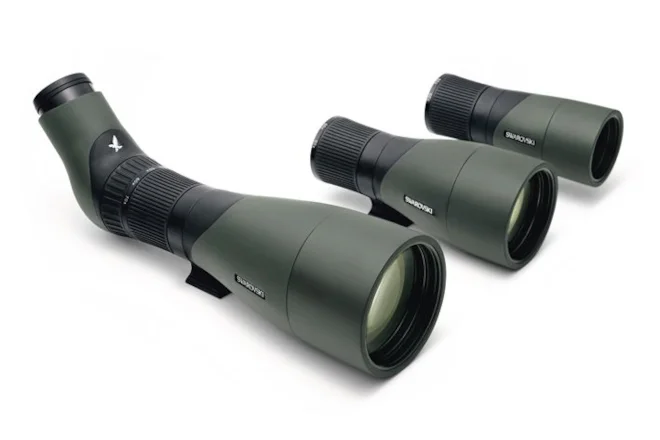Swarovski ATX 65 and 85 modular telescopes
| OUR VERDICT: The ATX has become the telescope to beat. Weight aside, it excels in every department. The image is free from colour cast or detectable chromatic aberration, and the sharpness and clarity are extremely impressive. |
It’s almost five months since Swarovski’s revolutionary ATX telescope range was presented to the world’s birding press (Birdwatch 242: 66-67). Soon afterwards it was an instant hit at the Birdfair, where all three models – 65 mm, 85 mm and 95 mm – were on public display for the first time, to much acclaim. Now, with dealers holding stock, it is garnering further attention.
The reason for all the fuss is simple: innovation. This new scope, currently available only in angled form (a straight version will follow soon), is not just a design refinement or an aesthetic update, but built to an entirely new blueprint. While superficially recalling the company’s ATS range, it has two fundamental differences – both of them true innovations introduced for the first time in any birding telescope.
The most significant is the modular design, which allows the scope to be separated into two parts by pressing a discreet button on the underside of the eyepiece housing. This in turn retracts a locking pin, enabling the housing to be turned and released from its bayonet fixing. Fitting the two parts back together simply requires two dots on the facing plates to be aligned and the twist-release manoeuvre to be performed in reverse.
For any birder who, for example, struggles to pack equipment for trips while trying to observe strict cabin-baggage weight allowances, this facility is a godsend. Just take the scope apart and put it in your jacket pockets – Birder 1, Ryanair 0.
A further benefit of this modularity is the interchangeability of objective lenses – for the first time, an optics company is venturing into territory long since occupied by SLR camera manufacturers. Granted, you will need a significant budget to invest in more than one ATX objective lens, but in principle it’s possible to use an 85 mm or 95 mm objective as your primary lens when birding that estuary or reservoir local patch, while keeping the lighter and more portable 65 mm for overseas trips, where weight and space are at a premium. I did just that, testing the 65 mm while leading the Birdwatch reader tour to the Azores in October, and using the 85 mm back home on my London local patches.
The second key design difference is that the ATX features a built-in zoom instead of interchangeable eyepieces – there is no fixed magnification option. The new zoom mechanism is at the ‘interior’ end of the eyepiece housing, with the magnification adjusted by a wheel on the barrel next to the objective lens’s focusing ring. The zoom range of the new set-up is 25-60x on the 65 mm and 85 mm models, and an impressive 30-70x on the supersize 95 mm version.
I mentioned in the earlier preview that the new position of the focusing ring takes some getting used to. Practice, however, does indeed make perfect, and after a week on the Azores using the telescope constantly, it was instinctive – and indeed preferable, as zooming and focusing operations are now right next to each other, simplifying finger movements.
It also means that the eyepiece end of the telescope is freed up for easier digiscoping. This new, wider eyepiece lens is designed specifically with this in mind, as are new DCB II and TLS APO digiscoping adapters, the latter even featuring its own APO mini-lens to give a focal length of 750-1,800 mm. I’ve yet to test the adapters properly, but achieved acceptable digiscoping results – with minimal vignetting even using the 5x zoom on Canon’s S100 compact – simply by handholding the camera against the eyepiece.
Back to observation, and both the 65 mm and the 85 mm versions are superb. With its greater light-gathering power, the 85 mm performed particularly well, and the improvement over Swarovski’s existing ATS 80 HD was discernible in both daytime and low-light situations. The image appeared free from colour cast or detectable chromatic aberration, and the sharpness and clarity are extremely impressive.
It wasn’t practical to field test the 95 mm model at the same time, but having used it for several days at the press launch I can vouch for its exceptional image quality. The trade-off, of course, is the larger objective’s narrower field of view and weight gain, the latter being 240 g heavier than the 1,910 g 85 mm model and 565 g more than the 65 mm. By comparison, the ATS 80 HD – which the company is continuing to manufacture – weighs in with the 25-50x zoom at a total of 1,675 g, so while the new ATX can list many advantages, weight isn’t one of them.
In short, with its innovative design and state-of-the-art performance, the ATX has become the telescope to beat. Weight aside, it excels in every department, and the introduction of modularity, in particular, is an upping of the ante which will surely force other manufacturers to look again at their own product ranges.
Tech spec |
|||
Price: Size: Weight: Field of view (m at 1,000 m): Close focus: Gas-filled: Waterproof: Guarantee: |
65 mm £640* 339 mm 1,585 g 23-41 mm 2.1 m yes yes 10 years |
85 mm £1,110* 372 mm 1,910 g 23.41 mm 3.6 m yes yes 10 years |
95 mm £1,380* 462 mm 2,150 g 19-35 mm 4.8 m yes yes 10 years |
*eyepiece costs £1,570


